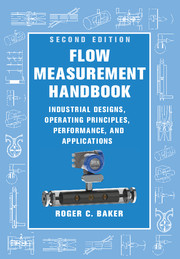Book contents
- Frontmatter
- Dedication
- Contents
- Preface
- Acknowledgements
- Nomenclature
- 1 Introduction
- 2 Fluid Mechanics Essentials
- 3 Specification, Selection and Audit
- 4 Calibration
- 5 Orifice Plate Meters
- 6 Venturi Meter and Standard Nozzles
- 7 Critical Flow Venturi Nozzle
- 8 Other Momentum-Sensing Meters
- 9 Positive Displacement Flowmeters
- 10 Turbine and Related Flowmeters
- 11 Vortex Shedding, Swirl and Fluidic Flowmeters
- 12 Electromagnetic Flowmeters
- 13 Magnetic Resonance Flowmeters
- 14 Ultrasonic Flowmeters
- 15 Acoustic and Sonar Flowmeters
- 16 Mass Flow Measurement Using Multiple Sensors for Single-Phase Flows
- 17 Multiphase Flowmeters 508
- 18 Thermal Flowmeters
- 19 Angular Momentum Devices
- 20 Coriolis Flowmeters
- 21 Probes for Local Velocity Measurement in Liquids and Gases
- 22 Verification and In Situ Methods for Checking Calibration
- 23 Remote Data Access Systems
- 24 Final Considerations
- References
- Main Index
- Flowmeter Index
- Flowmeter Application Index
6 - Venturi Meter and Standard Nozzles
Published online by Cambridge University Press: 05 August 2016
- Frontmatter
- Dedication
- Contents
- Preface
- Acknowledgements
- Nomenclature
- 1 Introduction
- 2 Fluid Mechanics Essentials
- 3 Specification, Selection and Audit
- 4 Calibration
- 5 Orifice Plate Meters
- 6 Venturi Meter and Standard Nozzles
- 7 Critical Flow Venturi Nozzle
- 8 Other Momentum-Sensing Meters
- 9 Positive Displacement Flowmeters
- 10 Turbine and Related Flowmeters
- 11 Vortex Shedding, Swirl and Fluidic Flowmeters
- 12 Electromagnetic Flowmeters
- 13 Magnetic Resonance Flowmeters
- 14 Ultrasonic Flowmeters
- 15 Acoustic and Sonar Flowmeters
- 16 Mass Flow Measurement Using Multiple Sensors for Single-Phase Flows
- 17 Multiphase Flowmeters 508
- 18 Thermal Flowmeters
- 19 Angular Momentum Devices
- 20 Coriolis Flowmeters
- 21 Probes for Local Velocity Measurement in Liquids and Gases
- 22 Verification and In Situ Methods for Checking Calibration
- 23 Remote Data Access Systems
- 24 Final Considerations
- References
- Main Index
- Flowmeter Index
- Flowmeter Application Index
Summary
Introduction
In this chapter, we are concerned with devices defined in international standard documents. Among these, the Venturi meter is one of the oldest industrial methods of measuring flow, although other methods may be more common. Chapter 8 deals with other devices such as variable area meters, target meters, averaging pitot tubes, Dall meters, V-cone meters and other Venturi, nozzle and orifice-like devices.
As in the case of the orifice plate, the reader should have access to a copy of the latest version of the ISO standard (5167). I have refrained from repeating information that should be obtained from the standard, and include only the minimum information to provide an understanding of the discharge coefficients, the likely uncertainty of the various devices and the type of material from which they may be constructed. There is a growing interest in the use of some of these devices for difficult metering tasks and a re-evaluation of their behaviour. Recent publications are briefly reviewed in Appendix 6.A.
Spink (1978) suggested that a standard orifice should be used unless:
• The velocity is such as to require the value of β to exceed 0.75: if higher differential pressure or larger pipe is not possible, he suggested considering a flow nozzle.
• The fluid contains a second phase of some sort – particulate, bubble or droplet – in suspension: either a Venturi or a flow nozzle with vertically downward flow, an eccentric or segmental orifice, or a different type of device such as a target meter or electromagnetic flowmeter should be considered.
• The fluid is very viscous or results in low Reynolds number flows: the meters already mentioned may be suitable, or a quadrant or semi-circular orifice may be worth considering.
• The flow is very low and the fluid very clean: an integral orifice or a small calibrated meter run may be appropriate.
• Pumping costs are a major consideration: in which case go to a lower-loss device.
If a liquid or a gas flows down a pipe of decreasing cross-section, the velocity (provided, in the case of a gas, that it is below the speed of sound) increases as the area decreases, and the pressure also decreases with the increase in velocity. This behaviour allows the measurement of the change in pressure as a means of obtaining the flow rate in the duct.
- Type
- Chapter
- Information
- Flow Measurement HandbookIndustrial Designs, Operating Principles, Performance, and Applications, pp. 163 - 176Publisher: Cambridge University PressPrint publication year: 2016



